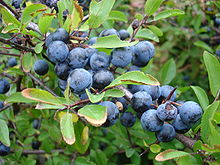
Back مادة قابضة Arabic Astrinxencia AST Astringent Catalan Adstringens Czech Adstringens German Adstringo Esperanto Astringencia Spanish قابض Persian Adstringentti Finnish Astringence French


An astringent (sometimes called adstringent) is a chemical that shrinks or constricts body tissues. The word derives from the Latin adstringere, which means "to bind fast". Astringency, the dry, puckering or numbing mouthfeel caused by the tannins[1][2] in unripe fruits, lets the fruit mature by deterring eating. Tannins, being a kind of polyphenol, bind salivary proteins and make them precipitate and aggregate,[3][4][5] producing a rough, "sandpapery", or dry sensation in the mouth.
Squirrels, wild boars, and insects can eat astringent food as their mouths are developed to be resistant to its effects.[6]
In Ayurveda, astringent is the sixth taste (after sweet, sour, salty, pungent, bitter) represented by "air and earth".[7][8]
Smoking tobacco is also reported to have an astringent effect.[9]
In a scientific study, astringency was still detectable by subjects who had local anesthesia applied to their taste nerves, but not when both these and the trigeminal nerves were disabled.[10]
- ^ Ray, P. K. (2002). Breeding Tropical and Subtropical Fruits. Springer Science & Business Media. ISBN 9783540428558. Retrieved 2018-12-08.
- ^ Joslyn, Maynard (2012-12-02). Methods in Food Analysis: Applied to Plant Products. Elsevier. ISBN 9780323146814.
- ^ Fennema, Food Chemistry, 4th ed., p. 656.
- ^ Breslin, P.A.S.; Gilmore, M.M.; Beauchamp, G.K.; Green, B.G. (1993). "Psychophysical evidence that oral astringency is a tactile sensation". Chemical Senses. 18 (4): 405–417. doi:10.1093/chemse/18.4.405.
- ^ Bertsch, Pascal; Bergfreund, Jotam; Windhab, Erich J.; Fischer, Peter (August 2021). "Physiological fluid interfaces: Functional microenvironments, drug delivery targets, and first line of defense". Acta Biomaterialia. 130: 32–53. doi:10.1016/j.actbio.2021.05.051. hdl:20.500.11850/498803. PMID 34077806. S2CID 235323337.
- ^ Choi, Nak-Eon; Han, Jung H. (2014-12-03). How Flavor Works: The Science of Taste and Aroma. John Wiley & Sons. ISBN 9781118865453.
- ^ Desai, Urmila (1990). The Ayurvedic Cookbook: A Personalized Guide to Good Nutrition and Health. Lotus Press. ISBN 9780914955061.
- ^ Lad, Vasant (2002). Textbook of Ayurveda. Ayurvedic Press. ISBN 9781883725075.
- ^ McBride, Nome. "Herbal Smoking Mixes" (PDF). Traditional Roots Institute. Retrieved 2022-07-20.
- ^ Jiang, Yue; Gong, Naihua N.; Matsunami, Hiroaki (2014). "Astringency: A More Stringent Definition". Chemical Senses. 39 (6): 467–469. doi:10.1093/chemse/bju021. ISSN 0379-864X. PMC 4064959. PMID 24860069.